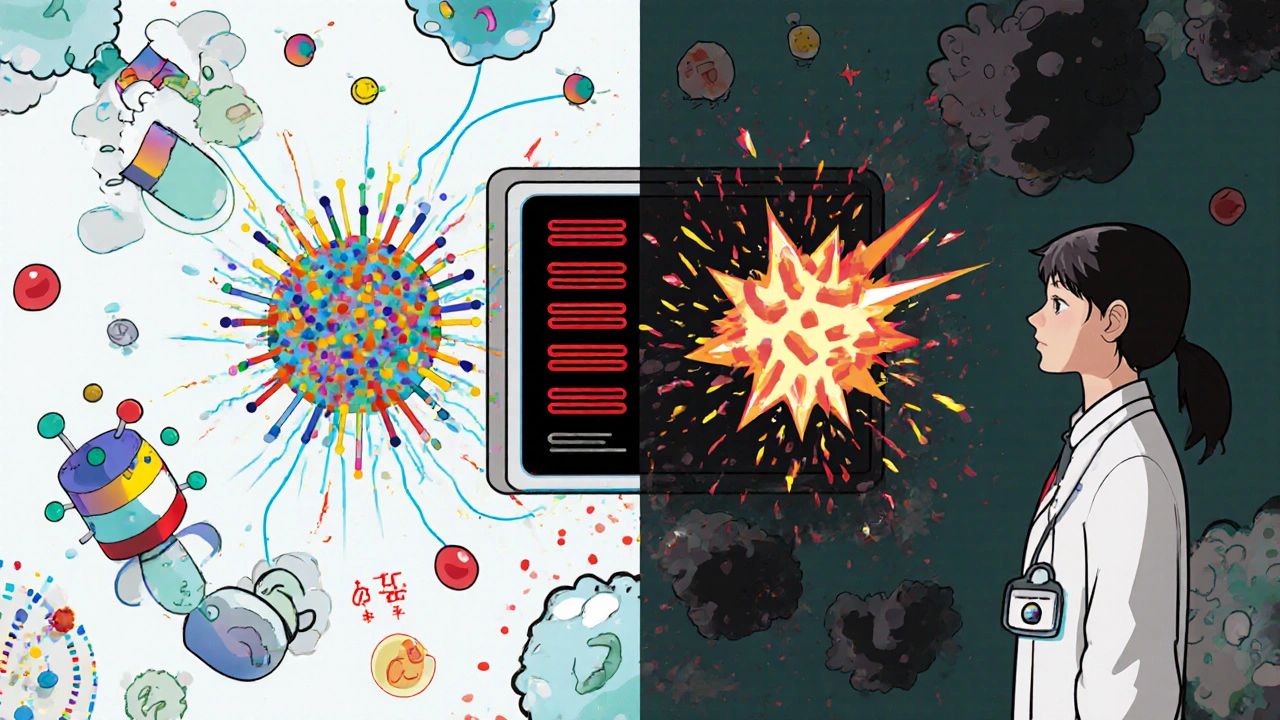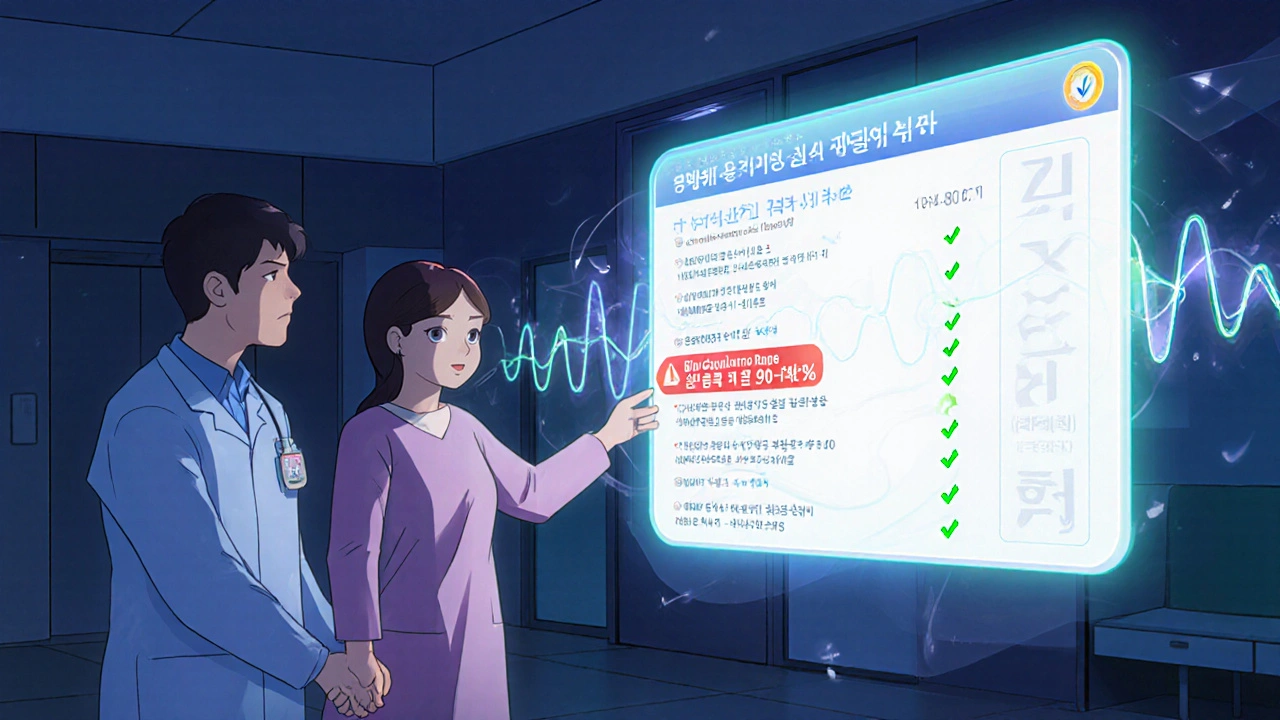
When a cancer patient gets a prescription for a combination therapy-say, FOLFOX with 5-fluorouracil, leucovorin, and oxaliplatin-they’re not just getting three drugs. They’re getting a carefully balanced system. Each component works at a specific time, in a specific way, and at a specific concentration to kill cancer cells without destroying the body. Now imagine swapping one of those drugs with a generic version. Sounds simple, right? But in oncology, that swap can change everything.
Why Bioequivalence Isn’t Just a Number
Bioequivalence is the standard used to prove a generic drug works the same as the brand. For most medications, regulators like the FDA look at two numbers: how much of the drug gets into the bloodstream (AUC) and how fast it peaks (Cmax). If those numbers fall between 80% and 125% of the brand’s, the generic is approved. That’s fine for blood pressure pills or antibiotics. But in cancer treatment, that range is too wide. Drugs like methotrexate, vincristine, or docetaxel have narrow therapeutic windows. That means the difference between a cure and a toxic reaction can be tiny. A 10% drop in concentration might make the drug ineffective. A 15% spike could cause nerve damage, low blood counts, or organ failure. The standard 80-125% range doesn’t account for that. Some experts, including Dr. James McKinnell at Johns Hopkins, argue that for combination therapies with narrow index drugs, the acceptable range should be tighter-90% to 111%. But that’s not yet the rule.The Combination Problem
Most cancer treatments today aren’t single drugs. About 70% of regimens involve two or more agents. That’s where bioequivalence gets messy. If you replace just one component of a combo with a generic, you’re not just changing one variable-you’re changing how all the drugs interact. Take R-CHOP, used for lymphoma. It includes rituximab (a biologic), cyclophosphamide, doxorubicin, vincristine, and prednisone. The biologic has to go through a biosimilarity process, which is entirely different from bioequivalence. The chemo drugs each need their own bioequivalence studies. But what happens when the generic version of vincristine has a slightly different formulation? It might release faster or slower. That alters how it interacts with the other drugs. A 2023 study from the Gulf Cancer Consortium found that 42% of oncologists had seen unexpected side effects or reduced effectiveness after switching just one generic component in a combo regimen. And here’s the kicker: regulators approve each drug in the combo separately. They don’t test the combo as a whole. So even if each generic passes bioequivalence on its own, the combination might behave differently than the branded version. That’s a gap in the system.Real Cases, Real Consequences
It’s not theoretical. Oncology pharmacists are seeing it happen. In March 2024, an oncologist on the ASCO Community Forum shared a case where switching to a generic vincristine in an R-CHOP regimen led to increased neurotoxicity. The patient developed severe numbness and tingling-signs of nerve damage. The generic version had a different excipient, which affected how quickly the drug entered the bloodstream. Peak concentrations were higher than expected. The patient had to stop treatment early. At the same time, other cases show success. A 2024 study at MD Anderson tracked 1,247 patients on generic capecitabine instead of branded Xeloda, combined with oxaliplatin. Survival rates were nearly identical-28.4 months versus 27.9 months. Side effects matched too. Why? Because capecitabine is a well-understood small molecule with predictable absorption. It’s a good candidate for generics. But not all drugs are that simple.
Cost vs. Safety: The Patient Dilemma
Generic cancer drugs save money. Big time. Branded drugs can cost $150,000 a year per patient. Generics? Often under $50,000. That’s why the global market for generic oncology drugs hit $38.7 billion in 2023 and is expected to grow to over $52 billion by 2027. But cost savings don’t mean patients are comfortable with substitution. A 2024 survey by Fight Cancer found that 63% of patients worry about switching to generics in combination therapies. Over 40% said they’d ask for the brand name-even if they had to pay more. Why? Because they’ve seen what happens when things go wrong. They’ve heard stories. They’ve been told, “This is just as good.” But in cancer, “just as good” isn’t good enough.How Systems Are Adapting
Hospitals aren’t just guessing. They’re building guardrails. The University of California, San Francisco, created a decision support tool that flags combination regimens with narrow index drugs. If a pharmacist tries to substitute a generic vincristine in R-CHOP, the system pops up a warning: “High risk. Clinical evidence not established for substitution.” Since rolling it out, inappropriate substitutions dropped by 63%. The Gulf Cooperation Council developed a scoring system for choosing generics. It looks at 12 factors: manufacturing quality (weighted 30%), regulatory approval (25%), cost (20%), supply reliability (15%), and patient trust (10%). If a generic scores low on quality or has a history of shortages, it doesn’t make the cut-even if it’s cheaper. And the FDA and EMA are catching up. The FDA launched the Oncology Bioequivalence Center of Excellence in 2024. The EMA now requires clinical endpoint studies for certain high-risk combos, not just blood tests. New guidelines from the International Consortium recommend food-effect studies for all oral combo components and tighter bioequivalence ranges for sensitive drugs.
What’s Next
The future of bioequivalence in oncology isn’t just about more testing. It’s about smarter testing. Physiologically based pharmacokinetic (PBPK) modeling is gaining traction. Instead of testing 24 healthy volunteers, researchers can simulate how a drug behaves in different body types, with different liver enzymes, with different food intake, and with other drugs present. The FDA’s 2023 draft guidance supports this approach. It could cut study times, reduce costs, and predict interactions before a single pill is ever given to a patient. By 2030, the National Cancer Institute estimates that 35-40% of current combination therapies will need specialized bioequivalence protocols. That means regulators, manufacturers, and hospitals will need to work together-not just approve each drug separately, but validate the whole system.What Patients and Providers Should Know
If you’re a patient: ask. Don’t assume a generic is automatically safe in your combo regimen. Ask your oncologist or pharmacist: “Has this substitution been studied in combination with my other drugs?” If you’re a provider: don’t rely on the Orange Book alone. Just because a drug has an “A” rating doesn’t mean it’s safe to swap in a complex regimen. Check your hospital’s formulary guidelines. Use decision tools. Know which drugs have narrow therapeutic windows. Document substitutions carefully. If you’re a policymaker: fund research on combination bioequivalence. Update guidelines. Recognize that one-size-fits-all bioequivalence doesn’t work in oncology.Bottom Line
Generic cancer drugs are a lifeline for millions. They make treatment affordable. But in combination therapies, bioequivalence isn’t a checkbox. It’s a complex puzzle. Each piece matters. And if you move one without checking how it affects the others, the whole picture changes. The goal isn’t to stop generics. It’s to make sure they’re used safely. In cancer, that means treating combinations as systems-not collections of individual drugs.Are generic cancer drugs always safe to substitute in combination therapies?
No. While many single-agent generics are safe to substitute, combination therapies involve multiple drugs that interact. Swapping one generic component can alter how all the drugs are absorbed, metabolized, or eliminated. This can lead to reduced effectiveness or increased toxicity, especially with narrow therapeutic index drugs like vincristine or methotrexate. Always check if the substitution has been studied in the specific combination.
Why is the standard 80-125% bioequivalence range too wide for cancer drugs?
Cancer drugs often have narrow therapeutic windows-meaning the difference between an effective dose and a toxic one is small. A 15% drop in drug concentration might make the treatment fail. A 15% increase could cause severe side effects. The 80-125% range allows for too much variability in these cases. Experts recommend tighter margins (90-111%) for high-risk combinations, but this isn’t yet standard across regulators.
Do biosimilars follow the same bioequivalence rules as chemical generics?
No. Biosimilars (like generic versions of trastuzumab or rituximab) are not considered bioequivalent. They’re evaluated under a different pathway (351(k)) that requires direct comparison of clinical outcomes-safety, purity, and potency-not just blood levels. This is because biologics are large, complex molecules made from living cells, not simple chemicals.
What role do hospital formularies play in generic substitution for cancer drugs?
Hospital formularies set the rules for which generics can be used. Many now require more than just FDA bioequivalence approval. They demand clinical data, supply reliability, manufacturing quality, and patient safety records. Some use scoring systems that weigh cost against risk. In fact, 68% of hospital formulary committees require additional clinical evidence before approving generic substitution in combination regimens.
Can pharmacists substitute generic components in a combination without prescriber approval?
In many places, yes-unless the prescription specifically says “dispense as written” or the drug has a narrow therapeutic index. But best practice is to avoid automatic substitution in cancer combos. Many institutions now use clinical decision support tools that block substitutions in high-risk regimens. Pharmacists should always consult the prescriber before switching any component in a combination therapy.
How are regulators changing their approach to combination therapy bioequivalence?
The FDA and EMA are moving away from testing individual components alone. The FDA launched the Oncology Bioequivalence Center of Excellence in 2024. The EMA now requires clinical endpoint studies for certain high-risk combinations. New international guidelines recommend testing the entire regimen as a unit and using modeling (like PBPK) to predict interactions. The goal is to shift from “each drug passes” to “the whole combo works the same.”
What’s the economic impact of not solving bioequivalence challenges in cancer combos?
The American Cancer Society estimates that if bioequivalence challenges were fully addressed, generic substitution in appropriate regimens could save the U.S. healthcare system $14.3 billion annually. But if substitutions lead to hospitalizations, treatment delays, or ineffective therapy due to poor bioequivalence, those savings vanish-and costs rise. The real cost isn’t just dollars-it’s patient outcomes.
12 Comments
Write a comment
More Articles

Naranjo Scale Guide: Assessing Adverse Drug Reaction Causality
Learn how the Naranjo Scale works, score adverse drug reactions, compare it with other tools, and apply it in clinical practice.

Top Alternatives to FelixForYou.ca for Telemedicine in 2025
Discover the leading alternatives to FelixForYou.ca, a Canadian telemedicine platform, focusing on digital healthcare options available in 2025. Highlighting Maple Health, Tia Health, Livewell, Telus Health, and Jill Health, this article provides insights into each service's offerings, pros, and cons. Whether looking for 24/7 access to healthcare professionals, adaptable programs, or specialized medical services, these alternatives cater to varied health needs. Consider factors such as accessibility, cost, and service range to choose the right telemedicine solution.
How to Maintain a Healthy Weight with a Skeletal Muscle Condition
Maintaining a healthy weight with a skeletal muscle condition can be challenging, but it's not impossible. It's essential to focus on a balanced diet, including plenty of fruits, vegetables, lean proteins, and whole grains. Regular, low-impact exercise like swimming, yoga, or walking can help strengthen muscles and improve overall fitness. Don't forget to consult with your doctor or a physical therapist to create a tailored exercise plan that suits your specific needs. Finally, remember to monitor your progress and listen to your body to ensure you're making consistent, healthy choices.
Brad Seymour
November 9, 2025 AT 19:12Man, I’ve seen this play out in my hospital. We switched a generic vincristine in an R-CHOP regimen and one patient ended up in the ICU with neuropathy. Not because the drug was bad-just because nobody checked how it interacted with the rest of the cocktail. We’ve got to stop treating cancer like it’s a flu shot. This isn’t just about cost-it’s about not killing people trying to save them.